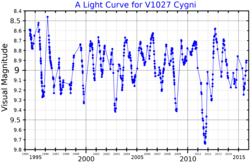| Observation data Epoch J2000 Equinox J2000 | |
|---|---|
| Constellation | Cygnus |
| Right ascension | 20h 02m 27.376s [2] |
| Declination | +30° 04′ 25.49″ [2] |
| Apparent magnitude (V) | 8.6-9.6 [1] |
| Characteristics | |
| Evolutionary stage | Yellow supergiant [3] |
| Spectral type | G7Ia [3] |
| U−B color index | +1.9 –+2.8 [1] |
| B−V color index | +2.1 –+2.5 [1] |
| Variable type | L [4] |
| Astrometry | |
| Proper motion (μ) | RA: −2.936 [2] mas/yr Dec.: −5.55 [2] mas/yr |
| Parallax (π) | 0.2390±0.0178 mas [2] |
| Distance | 14,000 ± 1,000 ly (4,200 ± 300 pc) |
| Absolute magnitude (MV) | −7.956 [3] |
| Details | |
| Mass | 10.3 [5] M☉ |
| Radius | 559 [3] [a] R☉ |
| Luminosity | 176,200 [3] L☉ |
| Surface gravity (log g) | −0.81 [6] cgs |
| Temperature | 5,000 [3] K |
| Metallicity [Fe/H] | −0.42 [5] dex |
| Other designations | |
| HD 333385, TYC 2670-4475-1, 2MASS J20022738+3004252 | |
| Database references | |
| SIMBAD | data |
V1027 Cygni is a luminous yellow supergiant star located in the constellation of Cygnus, about 14,000 light years away. For a time, it was thought that it could be a low-mass post-AGB star, however recent parallax measurements published in Gaia DR3 have shown this to likely not be the case, and instead it is likely a massive yellow supergiant star. [3]

